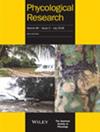Sphaerothrix gracilis gen.
IF 1
4区 生物学
Q2 MARINE & FRESHWATER BIOLOGY
引用次数: 0
摘要
摘要蓝藻是一种古老的生物,对水生生态系统中的初级生产贡献巨大。尽管蓝藻是存在于多种环境中的一类微生物,但它们在人为基质(即微塑料)上的多样性在很大程度上仍不为人所知。在本研究中,我们描述了一种来自 Nodosilineaceae 家族的蓝藻新属和新种。菌株是从新加坡海峡海滩沉积物中获得的泡沫微塑料颗粒中分离出来的。该物种在形态上与多态的世界性蓝藻属(Leptolyngbya spp.)相似,但在 16S rRNA 系统发育中形成了一个独立的支系,并具有独特的 16S-23S 内部转录间隔二级结构。迄今为止,尚未从微塑料颗粒表面分离和培养出蓝藻。利用形态学、系统发生学和生态学特征相结合的多相方法,我们描述了一个新属和新种 Sphaerothrix gracilis。某些蓝藻漂流到微塑料表面可能表明它们被长距离迁移到新的生态系统中,从而对毒性和生物多样性产生影响。本文章由计算机程序翻译,如有差异,请以英文原文为准。
Sphaerothrix gracilis gen. et sp. nov. (Nodosilineales, Cyanobacteria): a novel filamentous cyanobacterium isolated from tropical coastal microplastics
SUMMARYCyanobacteria are ancient organisms that contribute significantly to primary production in aquatic ecosystems. Although they are a group of microbes present in a wide range of environments, their diversity on anthropogenic substrates, namely microplastics, is still largely unknown. In the present study, we describe a new genus and species of cyanobacteria from the Nodosilineaceae family. Strains were isolated from foam microplastic particles obtained from beach sediments facing the Singapore Strait. This species is morphologically similar to the polyphyletic, cosmopolitan Leptolyngbya spp.; however, it forms an independent clade with 16S rRNA phylogeny and has a unique 16S–23S internal transcribed spacer secondary structure. To date, no cyanobacteria have been isolated and cultured from the surfaces of microplastic particles. Using a polyphasic approach combining morphological, phylogenetic and ecological traits, we describe a new genus and species Sphaerothrix gracilis. The presence of certain cyanobacteria rafting on microplastic surfaces can potentially indicate a long‐distance transport into new ecosystems with implications on toxicity and biodiversity.
求助全文
通过发布文献求助,成功后即可免费获取论文全文。
去求助
来源期刊

Phycological Research
生物-海洋与淡水生物学
CiteScore
3.60
自引率
13.30%
发文量
33
审稿时长
>12 weeks
期刊介绍:
Phycological Research is published by the Japanese Society of Phycology and complements the Japanese Journal of Phycology. The Journal publishes international, basic or applied, peer-reviewed research dealing with all aspects of phycology including ecology, taxonomy and phylogeny, evolution, genetics, molecular biology, biochemistry, cell biology, morphology, physiology, new techniques to facilitate the international exchange of results. All articles are peer-reviewed by at least two researchers expert in the filed of the submitted paper. Phycological Research has been credited by the International Association for Plant Taxonomy for the purpose of registration of new non-vascular plant names (including fossils).
 求助内容:
求助内容: 应助结果提醒方式:
应助结果提醒方式:


